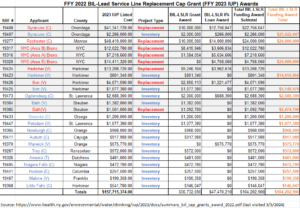According to the Centers for Disease Control there is no safe level of lead exposure. Exposure to lead has been linked to various health and behavioral issues, especially in children. Even low levels of lead, which were once considered safe, can cause severe and permanent harm to the developing brains and nervous systems of infants and young children. Lead exposure can limit a child’s cognitive ability, cause behavioral problems, and affect their ability to concentrate and learn in school.
A service line is a pipe that connects the water main on the street to a residential or commercial building. Unfortunately, many service lines are made of lead or contain lead components which can flake off and contaminate drinking water. In April 2023, the US Environmental Protection Agency (EPA) estimated that there were at least 494,000 lead service lines in New York State, making it one of the top six states with the most lead service lines.
In October 2021, the Infrastructure Investment and Jobs Act (IIJA) was passed, which provides $15 billion to states for replacing lead service lines. This is the largest amount of funding ever invested by the federal government for this purpose. The Bipartisan Infrastructure Law, as the IIJA is also known, provides a supplemental appropriation for the Drinking Water State Revolving Fund (DWSRF) program to finance lead service line identification and replacement projects.
At least $500 million will be pushed out to New York State’s water suppliers over the next five years to identify and replace lead service lines thanks to the federal Bipartisan Infrastructure Law. The NYS State Department of Health and the Environmental Facilities Corporation are working in partnership to administer this program. Applicants are invited to apply for project funding and eligible projects are awarded grants (49% set aside for Disadvantaged Communities) and/or interest-free financing.
In 2023, the first round of BIL fund distribution, $104 million was awarded to 18 applicants for 24 projects related to lead service line inventory or replacement:
- Topping the list of awards was the City of Syracuse which received just over $25 million, mostly for replacement work and the rest for inventory completion.
- New York City and the City of Rochester each received $24 million for pipe replacement work.
- Two communities in Herkimer County facing significant spikes in lead contaminated water were awarded just over $19 million with the Village of Herkimer receiving just over $14 million and the Village of Illion receiving just over $5 million dollars.

Despite the good news about $104 million being awarded in this first round of BIL funding, the troubling news is that there were 78 applicants for 85 other projects totaling over $211 million that went unfunded. That means, for every dollar awarded approximately another two dollars was requested but unfunded.
A list of projects under consideration for a second round of BIL funding was recently released by the state. Competing for this round of funding are 119 applicants for 138 projects totaling $327 million dollars. The total Round 2 awards will be approximately $111 million meaning, again, for every dollar awarded approximately another two dollars will be requested but go unfunded. This consistent discrepancy clearly indicates the high demand and urgency to have more funds available for inventory and replacement work.
NYLCV will be monitoring the progress over the years as well as advocate for additional funding from the federal government and state to address the growing backlog.
NYLCV Lead (Pb) Researcher Scarlett Gonzalez contributed to this blog post
